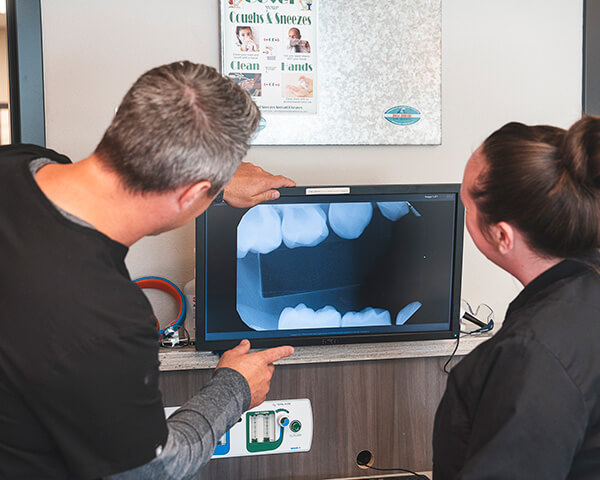Fluoride

What is fluoride?
Lower your Little Surfer's risk for cavities!
Fluoride is a natural mineral that helps safeguard teeth against decay. It strengthens your child’s teeth and lowers their risk of cavities, and it can even reverse the early signs of tooth decay!
Alongside regular brushing, flossing, and visits to your pediatric dentist, fluoride is a vital component of your little surfer’s oral health routine.
How does fluoride work?
When your child eats or drinks, the bacteria in their mouth consume the sugars from their diet, resulting in acid that attacks their teeth. This acid erodes calcium and phosphate, increasing the risk of decay.
Saliva plays an important role in defending teeth against these acid attacks, but it’s often not enough. This is where fluoride becomes essential!
Fluoride helps strengthen and remineralize the enamel on teeth. It repairs weakened areas and offers protection against cavities.
Various Sources of Fluoride
There are several ways your little surfer can enjoy the benefits of fluoride. Here are the most common methods!
Water
Water fluoridation is the process of adjusting fluoride levels in public water systems to help prevent cavities. As of 2016, 72.8% of the U.S. population had access to fluoridated water. However, certain sources, such as well water, may not contain the recommended levels of fluoride needed for optimal cavity protection. This topic will be addressed during your child’s dental visit.
Diet
Fluoride can be found in various foods and beverages, with processed items typically containing higher levels of it. However, consuming excessive amounts of fluoride isn’t always beneficial (check our FAQ for more details on this). Encouraging your child to eat a balanced diet will help ensure they receive a healthy and adequate amount of fluoride.
Toothpaste
Brushing teeth with fluoride toothpaste is a highly effective method, as it allows the enamel to absorb fluoride directly. The American Academy of Pediatric Dentistry advises that children use fluoridated toothpaste (refer to our FAQ below for the recommended amounts). Your child can also receive fluoride from using fluoridated mouthwash.
Treatment
Our pediatric dentists in Moses Lake provide a topical fluoride treatment that is stronger than other sources, making it super effective in fighting off cavities. We recommend this treatment for children under 16 at least twice a year. If your little one shows any signs of decay, we might suggest using silver diamine fluoride.
You might be curious—what’s the best source of fluoride? At Smile Surfers Kids Dentistry, we believe in a fun mix of all four!
What To Know About Sweets
FAQs About Fluoride
Take a look at the answers below!
What is silver diamine fluoride?
Silver diamine fluoride is a clear blue liquid that contains both silver and fluoride. The silver works to penetrate the enamel surface and eliminate cavity-causing bacteria, while the fluoride helps remineralize and strengthen the tooth. When used together in silver diamine fluoride, they can effectively slow down or halt dental decay.
If your child shows signs of decay but is too young or unable to undergo restorative treatment right now, we may suggest using silver diamine fluoride. This treatment can prevent decay from worsening and give us time until your child is ready for the appropriate treatment.
Is fluoride safe for children?
Yes, it is safe when used in small amounts.
Fluoride dental products, such as toothpaste and mouthwash, are safe as long as they are not ingested. Swallowing too much fluoride can lead to dental fluorosis, which affects developing teeth under the gums and may result in white spots on the surface.
At Smile Surfers Kids Dentistry, both our topical fluoride treatment and silver diamine fluoride are safe and very effective.
How much fluoride toothpaste should my child use?
Until age three, children should use only a “small smear” of toothpaste spread across the narrow width of the toothbrush. For kids aged 3 to 6 years, a pea-sized amount of toothpaste is recommended. During this time, we encourage you to assist them with brushing, ensuring all their teeth are thoroughly cleaned, and to monitor them to prevent swallowing toothpaste.
The American Academy of Pediatrics advises using a toothbrush and fluoride toothpaste as soon as your little surfer’s first tooth appears.
How much does this treatment cost? Does insurance cover it?
Fluoride treatments are usually covered by dental insurance. In some cases, your insurance may only cover this treatment once a year. If that’s the case, we will work with you to find a solution so your child can receive the recommended fluoride treatments from the ADA and AAPD twice a year.
If you’d like a cost estimate or want to check your insurance coverage, please reach out to our friendly team!
What is a caries risk assessment?
A Caries Risk Assessment is a preventive test designed to evaluate your little surfer’s risk of developing cavities. With this information, our pediatric dentists can customize their at-home advice and treatment recommendations to help prevent dental issues.
Fluoride is an important factor in the Caries Risk Test, which is why we will want to know about your child’s:
- Water consumption
- Water quality
- Diet
- Toothpaste use
- Mouthwash
- Dental hygiene routine
Schedule an appointment to find out if your child is at risk for cavities.